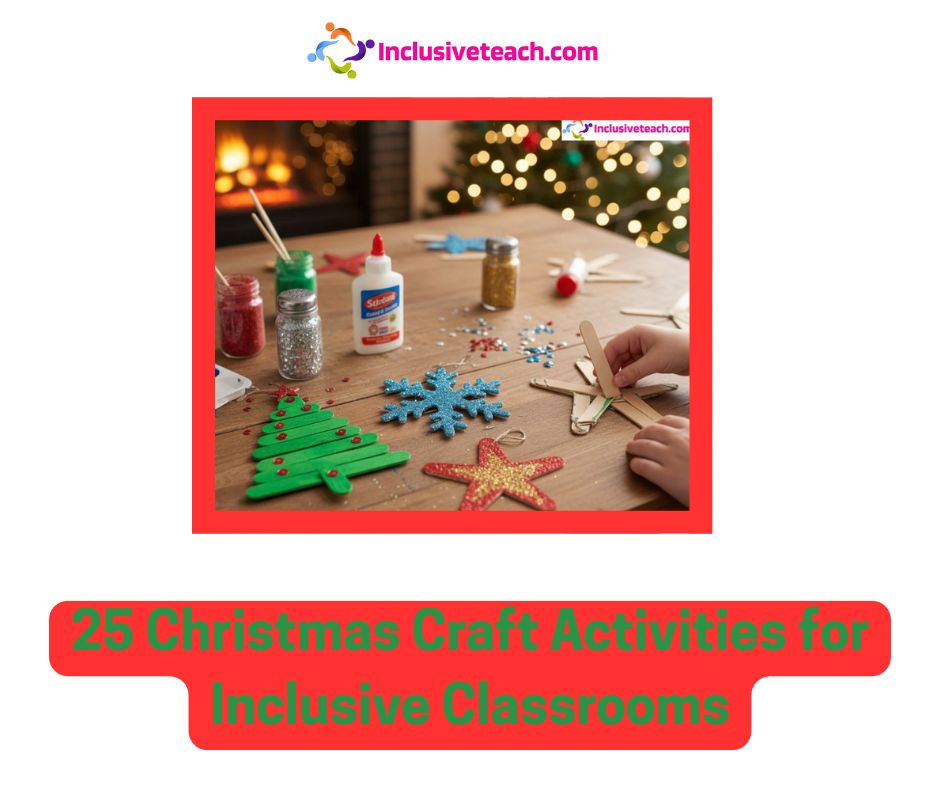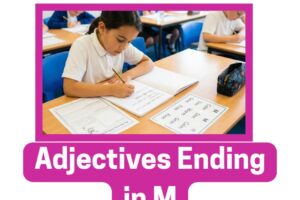
25 Christmas Craft Activities for Inclusive Classrooms
Christmas Craft Activities
Picture this: it’s the week before winter break, glitter is somehow already in your hair (and it’s only Monday), and you’ve got 25 eager faces waiting to create holiday magic. Whether you’re teaching neurotypical students, supporting diverse learners, or working with mixed-ability groups, finding Christmas crafts that work for everyone can feel like searching for a needle in a tinsel-covered haystack.
That’s where this collection comes in. These 25 Christmas craft activities for kids aren’t just festive and fun—they’re specifically designed for inclusive classrooms where every child deserves to create, celebrate, and shine. From toddlers developing fine motor skills to older students who need sensory-friendly options, each craft includes practical adaptations that transform “I can’t do this” into “Look what I made!” No special equipment required, no Pinterest-perfect expectations, just real crafts for real classrooms where the joy is in the making, not the perfection.
1. Personalised Snow Globe
Transform a simple jar into a treasured keepsake by creating a snow globe featuring your child’s photo. Glue a laminated photo to the inside of a jar lid, add water, glycerin, and glitter, then seal tightly. When shaken, the glitter swirls around the child’s image like magical snowflakes. This craft develops fine motor skills and creates a wonderful gift for families.
Adaptations: Use larger jars for easier handling, or pre-glue photos for students who need support with precise placement.

2. Handprint Reindeer
Trace children’s hands in brown paint or paper to create adorable reindeer faces. The thumb becomes the reindeer’s face, while the fingers form the antlers. Add googly eyes, a red pom-pom nose, and you have Rudolph! This activity is perfect for developing body awareness and creating personalized holiday cards.
Adaptations: Use stamp pads for mess-free printing, or pre-cut hand shapes for tracing.

3. Paper Plate Christmas Wreath
Cut the center from a paper plate to create a wreath base. Children can decorate using torn green tissue paper, paint, or construction paper leaves. Add a red bow and small decorations like buttons, sequins, or dried cranberries for a festive touch.
Adaptations: Pre-cut the plate centers and provide larger decorative items for easier grasping.
4. Popsicle Stick Ornaments
Arrange popsicle sticks into stars, Christmas trees, or snowflakes. Glue together, paint in festive colors, and add glitter or sequins. These make excellent gifts and help develop spatial reasoning and pattern recognition.
Adaptations: Create templates or jigs to hold sticks in place while gluing.

5. Salt Dough Ornaments
Mix flour, salt, and water to create a moldable dough. Roll out and use cookie cutters to create shapes. After baking and cooling, children can paint and decorate their ornaments. This multi-sensory activity engages touch, sight, and even smell.
Adaptations: Use scented extracts in the dough for additional sensory input, or provide larger cutters.
6. Cotton Ball Snowman
Stack three circles of cardboard or paper in descending sizes. Children glue cotton balls to create a fluffy snowman, then add details with markers, buttons, and fabric scraps. This activity strengthens fine motor control and creativity.
Adaptations: Use larger cotton balls or pre-made pom-poms for easier handling.
7. Stained Glass Window Clings
Cover contact paper (sticky side up) in a frame or hoop. Children arrange tissue paper pieces to create colorful designs, then cover with another sheet of contact paper. Cut into shapes and stick to windows for beautiful light-catching decorations.
Adaptations: Provide pre-cut shapes and secure the contact paper firmly to the work surface.
8. Jingle Bell Bracelet
Thread jingle bells onto pipe cleaners to create festive bracelets. The sound provides immediate sensory feedback, and the activity develops bilateral coordination and fine motor skills.
Adaptations: Use larger bells and thicker pipe cleaners, or create necklaces instead for easier manipulation.
9. Toilet Paper Roll Christmas Tree
Cut cardboard tubes into rings of varying sizes. Stack them in a pyramid formation and glue together to create a 3D Christmas tree. Paint green and decorate with small ornaments, beads, or painted dots.
Adaptations: Pre-cut the rings and provide a base with placement guides.
10. Fingerprint String Lights
Draw a string line across paper and have children create colorful “light bulbs” using fingerprints in various colors. Add small details with markers once dry. This simple activity creates beautiful results with minimal frustration.
Adaptations: Use stamp pads or sponge daubers for easier printing.
11. Paper Chain Garland
Cut strips of construction paper and show children how to loop and glue them together. This classic craft builds sequencing skills and provides opportunities for pattern creation with different colors.
Adaptations: Pre-cut strips, use wider paper, or provide staplers instead of glue.
12. Clothespin Angel
Paint a clothespin, add a small wooden bead for the head, and attach coffee filter wings. These sweet angels can hang on the tree or stand on flat surfaces. The activity develops painting skills and attention to detail.
Adaptations: Use larger clothespins and pre-assembled heads.
13. Egg Carton Wreath
Cut individual cups from an egg carton, paint them green, and arrange in a circle to create a textured wreath. Add red berries made from pom-poms or painted paper. This recycling project teaches sustainability while creating art.
Adaptations: Pre-cut the cups and provide a circular template for arrangement.
14. Candy Cane Reindeer
Glue googly eyes and a red pom-pom nose to a candy cane. Add small pipe cleaner antlers for a simple, sweet craft that doubles as a treat. Perfect for a quick activity or party favor.
Adaptations: Use jumbo candy canes and larger decorative items.
15. Melted Crayon Ornaments
Grate old crayons and sprinkle into metal cookie cutters on a baking sheet. Bake briefly until melted, add a ribbon hole, and cool. These colorful ornaments catch the light beautifully and teach about transformation through heat.
Adaptations: Adult supervision required; students can choose colors and help with grating using a hand-over-hand approach.

16. Foam Sheet Gift Bags
Cut and decorate foam sheets to create small gift bags. Children can use hole punches, stickers, and markers to personalize their creations. This practical craft develops planning and construction skills.
Adaptations: Pre-cut the foam and pre-punch holes for lacing or assembly.
17. Coffee Filter Snowflakes
Fold coffee filters and cut patterns along the edges. Unfold to reveal unique snowflakes that can be decorated with glitter or markers. This activity teaches symmetry and cause-and-effect relationships.
Adaptations: Provide cutting guides or use pre-folded filters with cutting lines marked.
18. Pinecone Christmas Tree
Paint pinecones green and allow to dry. Add tiny pom-poms, beads, or paint dots as ornaments. Top with a small star cut from foam or cardboard. These natural crafts connect children with outdoor materials.
Adaptations: Use pre-painted pinecones or provide pinecones mounted on bases.
19. Paper Bag Gingerbread House
Stuff a paper lunch bag with newspaper and fold down the top to create a house shape. Children decorate with markers, construction paper, or paint to create their own gingerbread houses without the edible mess.
Adaptations: Pre-stuff and fold bags, or use small milk cartons as an alternative.
20. Puffy Paint Christmas Cards
Mix equal parts shaving cream and glue to create puffy paint. Children can draw Christmas designs that dry with a raised, textured surface. The sensory experience is as enjoyable as the final product.
Adaptations: Place paper inside a shallow box to contain the materials.
21. Button Christmas Tree
Arrange buttons in a tree shape on canvas or heavy paper. Children can glue buttons in various sizes and colors, creating texture and visual interest. This activity develops color sorting and pattern-making skills.
Adaptations: Provide larger buttons and pre-drawn tree outlines.
22. Ribbon Candy Cane
Glue red and white ribbons to a candy cane shape cut from cardboard. Alternatively, wrap the ribbons around the shape for additional fine motor practice. These decorations add elegance to any classroom display.
Adaptations: Use wider ribbons and provide ribbon that’s been cut to appropriate lengths.
23. Handprint Christmas Tree Card
Paint the child’s hand green and stamp it on folded cardstock to create a Christmas tree shape. Add a brown trunk at the wrist and decorate with fingerprint ornaments. Parents treasure these personalized keepsakes.
Adaptations: Use stamp pads or pre-painted hands for less mess.
24. Pasta Wreath Ornament
Glue various pasta shapes onto a cardboard ring. Once dry, children can paint the entire creation gold, silver, or green. Add a ribbon for hanging. This craft combines texture exploration with creative design.
Adaptations: Use larger pasta shapes and pre-made cardboard rings.
25. Felt Stocking Decoration
Cut two stocking shapes from felt and help children stitch or glue around the edges, leaving the top open. Decorate with sequins, buttons, fabric markers, or pom-poms. These can be used as small gift holders or decorations.
Adaptations: Pre-cut shapes, use fabric glue instead of stitching, or provide plastic needles with yarn for easier sewing.
Tips for Inclusive Crafting
- Prepare materials in advance: Pre-cutting, pre-measuring, and organizing supplies reduces frustration and allows all students to participate successfully.
- Offer choices: Provide options in colors, materials, or techniques to honor different preferences and abilities.
- Focus on process over product: Celebrate effort and creativity rather than perfection.
- Use adaptive tools: Consider ergonomic scissors, grippers for brushes, or textured materials for sensory needs.
- Build in breaks: Allow students to step away and return to projects as needed.
- Display all work: Create a gallery that celebrates every child’s unique creation.
These activities bring joy, learning, and inclusive celebration to your classroom this holiday season!
Related
Discover more from Special Education and Inclusive Learning
Subscribe to get the latest posts sent to your email.
Source link



